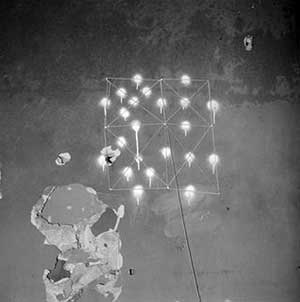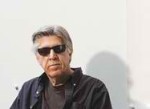
John Divola
American, 1949-
Vandalism Series, 1974-1975
Gelatin silver print
14 x 11"
Courtesy of the Artist

“I had just photographed some propane tanks; they were silver propane tanks, and when I printed them, I just loved the way they looked. The silver of the tank and the silver of the paper…and then it occurred to me that I could paint anything silver and photograph it. So I started driving around looking for objects to paint silver and, of course, you can’t just paint anything in the world because it all belongs to somebody. That’s how I ended up in the abandoned houses; I was looking for somewhere to start painting things silver.” - John Divola
COMMENTS
Jan: I’ve always thought of Zuma as your “breakthrough,” “career-making” work, and I was wondering what the exact timeline is here. Was it made during school?
John: The Zuma series was made three or four years after graduate school. I started out photographing social landscape imagery in the San Fernando Valley, so I went ahead and got the MA and had a show of that work. I then stayed one more year to get an MFA, and that’s when I started the Vandalism series. The work with abandoned houses arose out of two different sets of circumstances, the first being practical. I’d been driving around with a camera and I had just photographed some propane tanks; they were silver propane tanks, and when I printed them, I just loved the way they looked. The silver of the tank and the silver of the paper, there was something going on there, and then it occurred to me that I could paint anything silver and photograph it. So I started driving around looking for objects to paint silver and, of course, you can’t just paint anything in the world because it all belongs to somebody. That’s how I ended up in the abandoned houses; I was looking for somewhere to start painting things silver.
Jan: But, of course, the idea of using a photograph to document something that you do in the world is a different than using a photograph to document something in the world that you think has aesthetic potential.
John: Right, but they’re not mutually exclusive. I was always interested in intervening in a way that was visual or sculptural or performative, but not particularly interested that there be a clear line between what I had done and what was there. I wanted to do something in relation to what exists before the camera and not have it simply be a document of an act or an intervention, but a synthesis of what is given and what I add with a consciousness of the language of the document. So it is an aesthetic enterprise: basically just knowing that this thing is going to be translated from three-dimensions to two, and that light can be added, and that an abstract gesture can be inserted. It might just be a pattern, but it’s the knowledge that somehow that pattern is going to function in a certain way, or read a certain way, in a photograph.
Jan: You’ve often played with the flattening out of space via this movement back and forth between real deep-space of the world and what appears in the camera’s viewfinder. This movement allows one to set up situations to read a particular way in the final print, where the discrepancy between the worldly scene or referent and its photographic reproduction can actually be emphasized or exaggerated. Is there a particular line of development to those decisions? Did you start photographing the abandoned houses in a hands-off documentary fashion and then begin adding more and more marks to them?
John: No. One of the reasons, I think, I ended up in abandoned houses is that I didn’t have a studio. There was no way for me to deal with any other mode than documentary because I didn’t have any money to rent a studio. Once I started working in abandoned houses – and I didn’t go into it thinking, “I’ll make this a studio” – but it allowed me to think and act in a way that was somewhere between having a studio and being out in the world.
In the early-1970s, there were a lot of abandoned houses in Los Angeles. In the first one I worked in, I found a pair of wing-tipped shoes out in the yard, painted them silver, and photographed that, and then I found myself inside the house and began marking. But, very quickly, when I looked at those first photographs, I realized that certain patterns came off their surfaces, and I could play with space in the corners, and I could throw things in the air… All of a sudden, it was like a studio space already inscribed with a personality or character that I could move through and engage with in different ways.
Jan: So many of those abandoned houses literally are in a state between inside and outside; their ceilings are caving in, letting in the light… Within the context of the photograph, even the windows that look out of the space are touched by this inside-outside dialectic, right? This in-between state?
John: The inside-outside thing can really be traced through the three bodies of work. In the Vandalism series there’s occasionally a window, but very few; it’s mainly dealing with corners, planes of interior walls, and other attributes of the interior spaces. The [LAX NAZ] Forced Entry work is totally about inside-outside because I’m photographing where somebody has literally broken-in from the outside, so I’m photographing from the inside-out to the outside-in. And the Zuma work, from a formal point of view, is basically those two prior bodies of work synthesized, with color. The interest in marking from the Vandalism work plus the inside-outside interest from the Forced Entry work basically adds up to Zuma – just add color and the ocean.
- Jan Tumlir , Interview, "John Divola: On the Vandalism, Forced Entry, and Zuma series," May 2005
http://www.faculty.ucr.edu/~divola/Statements&Reviews/Three%20Acts/Interview.html
SBMA CURATORIAL LABELS
During his time as a graduate student in 1973, a recession had, once again, impacted the Western United States. Divola discovered abandoned houses throughout the greater Los Angeles area and he began using them as studios. He was interested not only in the random interventions by unknown participants, but also in consciously interacting with the spaces, making rudimentary, sometimes clumsy marks solely to enliven and “charge” the space with energy. For him, the spaces became more real and they made more interesting photographs. “I had concluded that everything is fabricated to be photographed…indeed performances are performed to be photographed,” Divola states.
Work from the Vandalism series came to the attention of the eminent Curator of Photography, John Szarkowski, who was organizing an exhibition titled Mirrors and Windows: American Photography Since 1960 for the Museum of Modern Art. In this exhibition, Szarkowski presented what he believed to be “the significant changes in the photographer’s place in American life and proposes a new critical framework for the appreciation of contemporary photography.” Divola, at the time of the exhibition, was a newly-minted MFA graduate who had just completed his breakthrough series titled Zuma Beach. A selection of prints from this important series is presently on view at the Pomona College Museum of Art.
- John Divola, As Far As I Could Get, 2013
